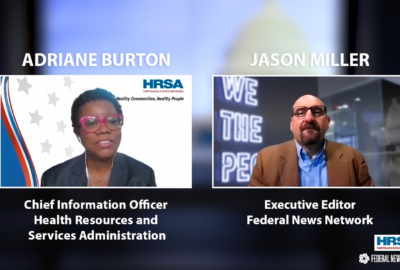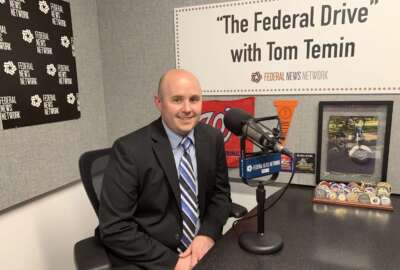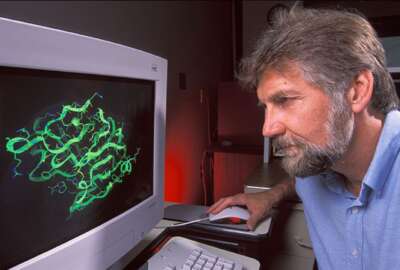This team from HHS has spent five years taking on the rural crisis of opioid use
The opioid scourge is as much a rural as an urban problem. The Health Resources and Services Administration (HRSA), part of Health and Human Services, has spent...
The opioid scourge is as much a rural as an urban problem. The Health Resources and Services Administration (HRSA), part of Health and Human Services, has spent five years and hundreds of millions of dollars in grants to rural health services providers to help battle a nearly overwhelming problem. For its work, the HRSA team leading the effort has been named a finalist in the Service to America Medals program. Federal Drive with Tom Temin spoke with two members in-studio: HRSA’s Rural Strategic Initiatives Director, Megan Meacham and Team Lead Sarah O’Donnell.
Interview Transcript:
Tom Temin Deputy director Allison Hutchens is the third member. She’s not with us today. But let’s get to the crux of the problem. Just tell us, what is the opioid scourge problem in rural America? I think we tend to focus on the cities a lot.
Megan Meacham Yeah. Tom, Absolutely. So back in 2018, when this initiative was created, we had data showing us what drug overdose deaths were occurring across the nation. And at the time the backdrop was that in rural communities there were actually a higher rate of deaths from overdose than in our urban communities. So like you said, you often think of urban communities, population centers as being where we should invest our funding and our attention. But really we found this gap and it was something we wanted to address. So we created the Rural Communities Opioid Response Program.
Tom Temin I guess that belief may be is a leftover of the crack cocaine days, which was mainly an urban problem.
Sarah O’Donnell Perhaps that could be part of it.
Tom Temin But it sounds like it took a data driven approach to this to discover the fact that there was this problem that, again, per capita was worse in rural than in urban.
Sarah O’Donnell Absolutely. Yeah.
Megan Meacham So CDC tracks overdose data deaths, and we knew what the numbers were. We also have rural health research centers that we find through our office, and they were able to track some of the data and show us what was happening in rural communities, along with not just the actual rate of overdose deaths, but the other challenges that rural communities face, such as workforce shortages or longer transportation distances to get to providers, fewer medication assisted treatment providers in particular.
Tom Temin And this is probably a good point at which to explain how HRSA itself works. You don’t deliver health services directly like some government agencies.
Megan Meacham Yeah. So the way that we get funding out to communities to support them in addressing the crisis is through a grant mechanism. And so basically what happens is we put out what’s called a notice of funding opportunity, which describes the purpose of what we would like communities to be doing to address their needs. And then they put in applications and through kind of an external unbiased process, the applications get evaluated and then funding goes out. But what’s really special about the programs that we have is that we write those funding opportunities, particularly to be flexible, understanding that if you’ve seen one rural community, you’ve seen one rural community. And so we make sure that we work in the ability for these communities to really address the needs and the unique needs that they have, you know, on the ground.
Tom Temin And just from an operational perspective, there are a network of providers that are funded by HRSA. So I guess maybe state funding goes into them that exist for general health care in rural areas. Did the grants go to the same institutions to expand their services, or did you also maybe grow new places that could help with specifically the opioids?
Sarah O’Donnell We for sure grew new places, so we have many grantees that this is the first time they’ve ever received federal funds, which is really exciting because we’re opening up a new world for these organizations and giving them new opportunities to serve the people living in their communities. And then kind of by the same token, we provide them a lot of support every step of the way. So we have a whole team of project officers who work with grantees every single day to make sure that they understand, you know, the web of the bureaucracy and the complex federal granting requirements. And then we also have technical assistance for these awardees as well. So especially for our new folks who are joining the federal family, they’re very well supported.
Tom Temin And is the federal funding to these existing and new organizations they’re only funding or do the states partner with you also?
Megan Meacham So I would say it’s definitely a collaborative approach. We provide one of the pots of funding. So as Sarah said, some of these grantees, our programs are kind of their first entrance into the federal funding, or it might be the first time with HRSA funding. Maybe they’ve only received SAMHSA funding in the past. So we really also work to emphasize that complementary approach and making sure that what our funds are doing are complementing and not duplicating what the other funds are doing. So we hear from grantees telling us, you know, with the SAMHSA state funds or with any other funds that we have, we’re able to do, you know, these amazing things. And then where we’re able to take and leverage your funds is filling these gaps of the things we’re not able to do. So we really are looking at that. You know, we’re trying to be good stewards of federal dollars and making sure that they can have a whole of community approach.
Tom Temin Because duplication of grants or services can be a problem too in expending federal dollars. And you want to make sure your dollars are uniquely used.
Megan Meacham Correct. And that’s what’s really neat about our program, is that so many of the other funding comes down and it’s again, it’s more either population centric, you know, population based hitting the larger cities or it’s coming through multiple streams before it gets out to the communities, whereas ours is direct funding straight to the communities to address their needs.
Tom Temin We’re speaking with Meaghan Meacham. She’s director of the Rural Strategic Initiatives Division at the Health Resources and Services Administration and with Sarah O’Donnell is a team lead there. They, along with Alison Hutchings, are finalists in this year’s Service to America Medals Program. And let’s talk about opioid problem itself. What do these organizations now that they’re funded? What do they do? What kind of services do they actually provide?
Sarah O’Donnell A lot of it depends on exactly what they need, but we cover the whole range. So from prevention services, we have grantees that work with children in schools to prevent opioid use when they become adults. There’s a wide variety of treatment services that are offered. So for opioid use in particular, we know that the evidence based approach is through medication assisted treatment. And so we have a lot of grantees who are supporting people in receiving medication assisted treatment, training providers to provide it, and then supporting those providers so that they don’t kind of feel alone and isolated when they’re in a rural community and faced with a patient that has opioid use disorder. We also support psycho stimulant use. We have a whole program that’s focused there. And those grants really help folks take both a mental health approach and a contingency management approach, which are kind of the evidence based methods for addressing psycho stimulant use and then recovery services. So providing recovery housing, setting up recovery community organizations, creating pathways for people in recovery to make sure that they can access housing and jobs. And I think what’s really great about a lot of the work that our grantees are doing is that it’s all encompassing. And so we really encourage folks to think about the whole human. So it’s great if you’re receiving treatment for your opioid use disorder, but it doesn’t help if you don’t have care for your kids or you don’t have food or you don’t have somewhere to live. And so as part of our programs, we support our grantees in addressing kind of that whole environment in which these individuals are living so they can really be successful.
Tom Temin Right? Because there are economic and social factors in rural areas and a lot of rural areas of the United States, small towns and stuff, You know, you ride through them, they look poor, they look like you know time left them. The factory closed 25 years ago, this kind of thing.
Sarah O’Donnell Yeah. I mean, they face a lot of challenges. I think it’s also important to note that rural communities have a special sort of resilience. The work that we’re seeing done there every single day is just truly inspiring. And so, yes, they face a lot of challenges, economic challenges, you know, distance to care. Meaghan named several of those access to health workforce. There’s just not as many people living there, Right. So not as many people to do the jobs or people leave, get their education and becoming a medical provider and then don’t return. But at the same time, the dedication and the resilience of our organizations in these rural communities is is just amazing. And the way that the community comes together to help these folks who are suffering from substance use disorder is is incredible.
Tom Temin How do you measure the program? How do you know you’re having a positive effect? I mean, it’s one thing to witness activity, but is there some kind of a metric that says, yes, we’re making progress here?
Sarah O’Donnell Yeah. So just like every federal program, we have performance metrics. We collect data from our grantees. So, you know, some of the things we look at is even just how many people receive direct services. So we know that our last fully grant year of data from our grantees, over 2 million rural residents received some sort of direct service prevention, treatment, Recovery Service. We know how many you know that more than 112,000 individuals received medication assisted treatment that might otherwise not have received it without these programs working in their communities.
Sarah O’Donnell I think it’s also important to note that it’s a lot of work for our grantees to collect all of this data, and we use that every single day. We use it to make sure that we’re giving them the technical assistance that they need. We use it to figure out what new programs we need to put out. And so it’s just so fundamental to our program is the data that we collect, not only because we report it out, but because we use it in our daily operations to make sure we’re doing the best we can for the communities we serve.
Tom Temin And do they submit it and do you collect it online? At least there’s not a lot of paper involved here.
Megan Meacham Correct? We definitely have an automated electronic system. You know, we have our own system of how we’re collecting the data. And then we actually have an evaluator as well who helps us with kind of like making sure that the data is clean and does the analytics of the data helps us determine what some of the best practices are based on the data, as Sarah said, you know, helps us determine where maybe technical assistance is needed if we’re not hitting certain benchmarks or seeing some of the data that we think we. We should be seeing, you know, where can we offer more assistance to the grant recipients to just help again, make sure we’re being the best stewards of federal dollars and having the best impact that we can?
Tom Temin And will this go on forever? Is there an endpoint to the program or I mean, opioids are still around.
Sarah O’Donnell So we definitely cannot speak to the federal budget. That is, you know..
Tom Temin Who can?
Sarah O’Donnell We do, what we’re what we’re given for as long as it is decided that this funding should continue to come to us at her. So we will be happy to continue managing this program and meeting the needs of rural communities.
Copyright © 2025 Federal News Network. All rights reserved. This website is not intended for users located within the European Economic Area.
Tom Temin is host of the Federal Drive and has been providing insight on federal technology and management issues for more than 30 years.
Follow @tteminWFED






